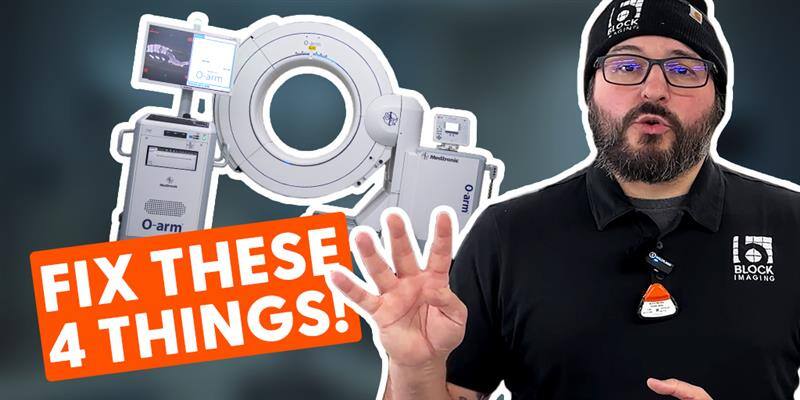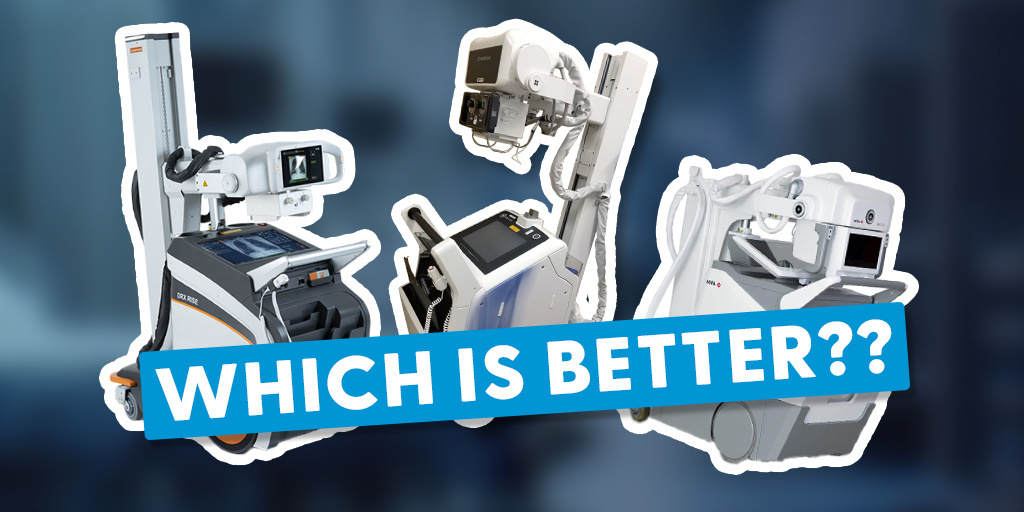
June 5, 2024 : 3 min read
From Mobile to R/F: Understanding Your X-Ray System Options
X-ray equipment is the most often used imaging equipment in the world behind ultrasound.
Almost every medical practice has some form of X-ray system, and most people are familiar with having received at least one X-ray examination in their lifetime.
However, despite their prevalence, we still have multiple conversations per week with customers about which type of X-ray is best for a specific use. Additionally, there’s often confusion around different options, which we’d love to help clear up. Here is a quick breakdown of the type of X-ray systems and a brief explanation of their most common uses.
Interested in pricing?
Check out our X-ray Machine Price Guide or contact us for more information on how Block Imaging can help you find the right system for your needs.
Mobile X-ray Systems: Compact and Lightweight
These are very compact, easy to transport systems most often used for house calls, typically with a DR panel. Their lightweight design allows them to be picked up and put in a vehicle. The tradeoff to this is in the smaller generator which results in less power. Despite that, this smaller generator does make this ideal for shooting through smaller anatomy and the mobile options have the lowest price point. An example of one of these systems is the AmRad Dragon (pictured).

The Portable X-ray
Although still mobile, the portable X-rays are much heavier and designed for use in hospitals or larger clinics. Their mobility makes them ideal for moving from room to room and performing studies on patients while they are in a bed or wheelchair. Though the price is a significant jump from the mobile option, these systems provide significantly more power at a reduced cost to a full X-ray room. The GE Optima 220 and 240 (pictured) are the most common systems in this category.

U-arm Systems and their Versatility
Also known as “straight arm,” these are fixed systems that are ideal for rooms with small dimensions. Often accompanied by a portable table, these systems are still accessibly priced, with a cost between that of a floor-mounted rad room and an overhead. Additionally, these can fit in a compact room while still offering a large amount of power and versatility. The GE Definium 5000 (pictured) is a popular example of these U-arm systems.

The Classic Floor-mounted rad room
This is likely what most people have in their head when they picture a full X-ray room. It is fixed to the floor, includes a table and a wall bucky, as well as a DR panel. There are various flavors of rad rooms with different levels of technology and other features. Most urgent cares and medium-sized clinics can find an option that is an excellent fit within this category. Depending on patient volume, these incredibly customizable to meet the right specifications and price point desired, allowing the customer to work within their budget. Popular examples of these types of systems on the refurbished market include the GE Brivo 385 and Siemens Multix on the used side. Amrad FMT Classic and DFMT are good options on the new side.

AmRad DFMT

GE Brivo

Siemens Multix
Elevated Care with Ceiling-mounted rad rooms
Often called an X-ray suite, a ceiling-mounted rad room is an overhead room with a rail system that facilitates ease of use for many studies. These are optimal for hospitals or large clinics with very high patient throughput. As a result of their capabilities, these systems also have the highest price tag. The GE Optima 646, Discovery 656 and Siemens Ysio are the most common systems in this category.

GE Optima 646

Siemens Ysio
Headline
Subheadline
R/F Rooms: X-Ray Meets Fluoroscopy
The least common and perhaps the least well-known of the bunch, are the R/F rooms. A combination of X-ray and fluoroscopy, these rooms are typically found in hospitals where they are used for more specialized gastrointestinal and swallow studies. As a result of the specialized studies, R/F rooms have the highest price tag. The most common systems in this category are the GE Precision 500D and Siemens Luminos.

GE Precision 500D

Siemens Luminos
Headline
Subheadline
Choosing the Right X-Ray System for Your Facility
We hope this quick guide was a helpful tool in learning more about the different kinds of X-ray systems!
If you’re curious about the next steps in choosing an X-ray system that best meets your facility’s needs and your budget, our team of experienced equipment managers can help you.
Don’t hesitate to contact us or check out our guide on How To Choose the Best X-ray Equipment for Your Facility. We have a breakdown of the most important factors to consider and helpful questions to ask.
Interested in pricing?
Check out our X-ray Machine Price Guide or contact us for more information on how Block Imaging can help you find the right system for your needs.

Clay Selby
Hello, I'm Clay, and I joined Block Imaging in 2021. I enjoy learning something new everyday about our industry and our customers. Block has an incredible work environment that fosters innovation and allows us to create unique solutions for our customers. Outside of work I love playing and watching sports, collect watches and drink craft coffee.





